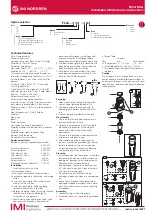
1: Safety
ShopTek™ ST4, ST5, ST7, ST11, ST15 Three-phase 60 Hz User Manual
88292018-236 R00
4
Subject to EAR, ECCN EAR99 and related export control restrictions.
cover eyes to exclude light. Call a physician immedi-
ately.
1.8
Electrical shock
A.
This compressor should be installed and maintained
in full compliance with all applicable Federal, State
and Local codes, standards and regulations, includ-
ing those of the National Electrical Code, and also
including those relative to equipment grounding con-
ductors, and only by personnel that are trained, qual-
ified and delegated to do so.
B.
Keep all parts of the body and any hand-held tools or
other conductive objects away from exposed live
parts of electrical system. Maintain dry footing, stand
on insulating surfaces and
DO NOT
contact any
other portion of the compressor when making adjust-
ments or repairs to exposed live parts of the electrical
system. Make all such adjustments or repairs with
one hand only, so as to minimize the possibility of
creating a current path through the heart.
C.
Attempt repairs in clean, dry and well lighted and
ventilated areas only.
D. DO NOT
leave the compressor unattended with open
electrical enclosures. If necessary to do so, then discon-
nect, lock out and tag all power at source so others will
not inadvertently restore power.
E.
Disconnect, lock out, and tag all power at source
prior to attempting repairs or adjustments to rotating
machinery and prior to handling any ungrounded
conductors.
1.9
Lifting
A.
If the compressor is provided with a lifting bail, then
lift by the bail provided. If no bail is provided, then lift
by sling. Compressors to be air-lifted by helicopter
must not be supported by the lifting bail but by slings
instead. In any event, lift and/or handle only in full
compliance with OSHA standards 29 CFR 1910 sub-
part N and/or any applicable Federal, State, and
Local codes, standards and regulations.
B.
Inspect points of attachment for cracked welds and
for cracked, bent, corroded or otherwise degraded
members and for loose bolts or nuts prior to lifting.
C.
Make sure entire lifting, rigging and supporting struc-
ture has been inspected, is in good condition and has
a rated capacity of at least the weight of the com-
pressor. If you are unsure of the weight, then weigh
compressor before lifting.
D.
Make sure lifting hook has a functional safety latch or
equivalent, and is fully engaged and latched on the
bail or slings.
E.
Use guide ropes or equivalent to prevent twisting or
swinging of the compressor once it has been lifted
clear of the ground.
F.
DO NOT
attempt to lift in high winds.
G.
Keep all personnel out from under and away from the
compressor whenever it is suspended.
H.
Lift compressor no higher than necessary.
I.
Keep lift operator in constant attendance whenever
compressor is suspended.
DANGER
All field equipment must be tested for electro-
static fields prior to servicing or making contact
with the machine using the following or equiva-
lent test equipment:
• 90 – 600 VAC: Volt detector such as
Fluke Model 1AC-A
• 600 – 7000 VAC: Voltage detector such
as Fluke Networks Model C9970
It is the responsibility of each organization to
provide/arrange training for all their associates
expected to test for electrostatic fields.











































